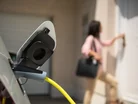Home for the holidays: five ways to extend your EV range

Opinion piece by Sammie Eastwood, Guest Editor.
A lot has happened this year. Most of us will be glad to see the back of 2022, although we’re not quite through the woods yet. We still have to overcome… the holiday season. For many this means driving across country to spend time with extended family. There’s packing, bickering with your partner as you try to stuff too many presents into the boot, all while herding a few hyperactive kids into the backseat. It can be a lot.
Then you remember… “we just bought an electric vehicle (EV)”.
You’ve heard about this dreaded “range anxiety” and suddenly there’s something new added to your already overloaded plate. How am I going to get all the way to Grandma’s on one charge? What if I can’t charge en route? The last thing we need is to be broken down in the middle of nowhere.
So, to keep those panic demons at bay. Here are five tips to help extend your EV’s range and get you home safe for the holidays.
Get planning
To start you will need to make sure to plan your route. Now you might be thinking, ‘I’ve been to Grandma’s house a million times, I know how to get there’. However, while you might be taking the quickest or most direct route, that doesn’t make it the most energy efficient. Planning your route to avoid fast and heavy traffic roads could significantly extend your battery.
This isn’t as difficult as it sounds since many Sat Navs allow you to find the most economical route with a few touches of a button. Plus, a new google maps update can help you plan a route that takes you past charging stations for that extra piece of mind. Meaning if you stop to refuel the family, there’s no reason you can’t add a touch more juice to the EV too.
Keep it sleek to avoid drag
It’s good practice to always check the car is in peak condition before setting off on a long journey, which includes making sure tyres are correctly inflated. Incorrectly inflated tyres will not only cause uneven wear on the tread but can also severely impact your energy efficiency. You will also want to make sure the car is as light as possible. Removing any roof, bike racks or unnecessary brick-a-brack will help shed those energy-leeching pounds from your vehicle.
Even keeping the car washed and polished can help with energy efficiency, as a dirty car has a surprising effect on drag. This might seem like a lot of work and maintenance, but you’ll really appreciate it when you’re just a few miles away and trying to eke the last drops of juice out of the EV.
Optimise your charging
You can optimise your charging by timing when you charge so your battery is at full capacity just before you start your journey. A fully charged battery will gradually drain if not used immediately, so charging at the right time will help get the most out of your battery life.
You can also wring more out of a full charge by only charging up to 80% during normal everyday commuting as this prevents the battery from getting degraded. The last 20% of charging puts the most strain on the power cells, so refraining from full charging day-to-day means you’ll get the most bang for your buck when you do need a full charge.
Wrap up warm (don’t use temp control)
Now, this is one nobody wants to hear but if you want to extend your EV range you’ll have to refrain from using the heater. Unlike internal combustion engine (ICE) vehicles, where heat is redirected from the engine, the heaters in an EV draw directly from stored energy meaning they will quickly deplete the battery.
However, don’t fear, there are ways you can avoid a chilly and miserable journey. Luckily, many EVs are fitted with Internet of Things (IoT) functions, which allow you to control features from the comfort of your home. Using these you can pre-warm, demist, etc. while the car is charging, meaning there is no need to run off reserve power to do this. Once the car is up to temp, you can set your climate control to eco mode, which will keep your car at a stable temperature without using too much additional energy.
Unfortunately, extreme outside temperatures will also have an effect on your energy consumption, so try to set off when the outside temp is as close to 20℃ as possible. This might be difficult in the dead of winter, but every little helps.
Drive smooth, slow and keep off the brakes
The final way to improve energy efficiency is with the way you drive. Just as with ICEs, aggressive driving is a fast way to burn through your energy. Yes, it might be fun to speed off at a green light or whiz down the motorway at 80 mph, but all that joyful acceleration is eating through your battery power just as fast.
If you want to extend your range, you need to keep that lead foot off the accelerator and drive smoothly and slowly. An optimum speed for energy efficiency is about 60 mph and use your vehicle's full regenerative braking mode as much as possible.
A great feature of EVs is that many of them include regenerative braking, which helps feed power back into the battery whenever you take your foot off the accelerator or tap the brakes. Learning to drive using regen over friction brakes will make the most of your stopping and could give you those extra few miles without recharging.
- Voltpost Secures Grants for Nationwide Lamppost EV ChargersCharging & Infrastructure
- San Francisco Expands Curbside EV Charging ProgrammeCharging & Infrastructure
- How Amazon hit one Billion Electric Deliveries in the USFleet & Commercial
- Antimony Crisis: Challenges & Opportunities for EVsTechnology

